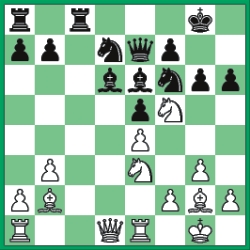|
Time Out
Calculating moves Chess
You can make just one move at a time. So you have to sort of limp towards your target with patience and concentration. Interestingly enough, you could beat the best players in the world if you were allowed to make two consecutive moves only once in a game!
A move is your only weapon and you must use it judiciously. A master knows how to do it, while a beginner often wastes this valuable thing for no good reason.
How many moves can a master calculate? Well, it depends on the position. There are highly complex positions where even a player of exceptional tactical ability may find himself groping. If he is attacking he has to analyse all the possibilities open to the defender -- an apparently insignificant slip can be very costly. The tension often runs high when a sacrificial attack is launched. The problem here is that you may reach a lost position if the attacks fails to achieve its goal of checkmating or recovering the sacrificed material with interest. Masters can and do calculate several moves. But it is not so much a question of the number of moves that he calculates as how many possibilities he has to deal with. For example, calculating 10 moves of more or less forced nature can be easier than finding the right continuation in a position where you may have to make only three or four correct moves in a maze of unfathomable complications.
Now let's have a look at quiet positions, not yet ready to burst into a conflagration. Here, calculating moves is not that important. It's positional understanding which counts most when there are no tactical threats and almost 'nothing' is happening over the board. It is perhaps this kind of position that world champion JR Capablanca had in his mind when he said, "I seldom calculate any move." Capablanca had a smooth, almost intuitive, style of play that his adversaries found difficult to handle. By the way, chess is different today -- hammer and tongs all the way!
Here is a typical Capablanca game.
White-Jose Raul Capablanca
Black -Anthony Edward Santasiere [A07]
New York 1931
1.Nf3 Nf6 2.b3 d5 3.Bb2 Bf5 4.g3 e6 5.Bg2 Nbd7 6.00 Bd6 7.d3 h6 8.Nbd2 Qe7 9.Re1 e5 10.c4 c6 11.cxd5 cxd5 12.e4 dxe4 13.dxe4 Be6 14.Nh4 g6 15.Nf1 00 16.Ne3 Rfc8 17.Nhf5 gxf5 18.exf5 e4 19.fxe6 Qxe6 20.Bh3 Qxh3 21.Qxd6 Rc6 22.Qf4 Re8 23.Rac1 Nh5 24.Qf5 Qxf5 25.Nxf5 Ree6 26.Rxc6 bxc6 27.Rd1 Ne5 28.Nxh6+ Kg7 29.Ng4 f6 30.Bxe5 fxe5 31.Re1 Kg6 32.Rxe4 Kf5 33.f3 Ng7 34.Ne3+ Kf6 35.Ra4 Rd6 36.Rxa7 Rd2 37.Ng4+ 1-0

Position after 17.Nhf5!
-PATZER
Copyright (R) thedailystar.net 2006
|
